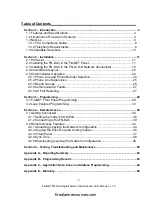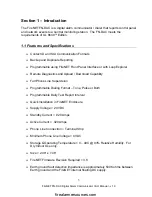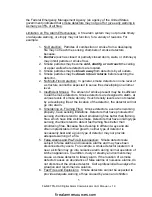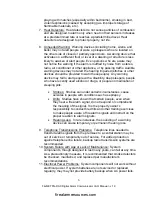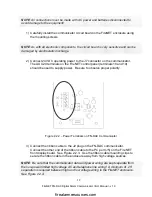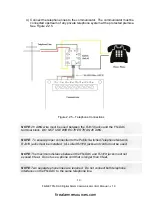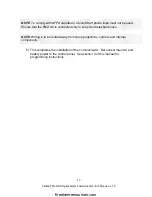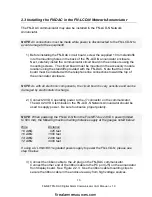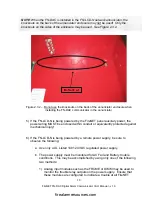
4
FireNET FN-DAC Digital Alarm Communicator I & O Manual - v 1.0
1.2 Limitations of Fire Alarm Systems
Follow Recommended Installation Guidelines: To achieve early fire detection, fire
detection sensors should be installed in all rooms and areas of a house, apartment,
or building in accordance with the recommendations of the National Fire Protection
Association Standard 72 (NFPA 72), manufacturer’s recommendations, state and
local codes, and the recommendations contained in Guide for the Proper Use of
System Smoke Detectors, which is made available at no charge to all installing
dealers. Generally, the standards and recommendations include the following (but
installers should refer to the specific guidelines above before installing):
•
Sleeping
Rooms: Smoke detectors should be installed in every sleeping
room.
•
Hallways: More than one smoke detector should be installed in a hallway if it
is more than 30 feet long.
•
At least Two Smoke Detectors: There should never be less then two smoke
detectors per apartment or residence.
•
Smoke Detectors in Alarm, Electrical, or Phone Locations: Smoke detectors
should be located in any room where an alarm control is located or an alarm
control connects to an electrical source or phone line. If detectors are not so
located, a fire within the room could prevent the alarm control from reporting
a fire.
•
Notification
Systems: All fire alarm systems require notification devices,
including sirens, bells, horns, and/or strobes. In residential applications, each
automatic alarm initiating device when activated should cause the operation
of alarm notification device that should be clearly audible in all bedrooms
over ambient or background noise levels (at least 15dB above noise) with all
intervening doors closed.
•
Alarm in Every Bedroom and Level of Residence: A smoke detector with an
integral sounder (smoke alarm) should be located in every bedroom and an
additional notification device should be located on each level of a residence.
•
Maintenance: A maintenance agreement should be arranged through the
local manufacturer’s representative and maintenance should be performed
annually by authorized personnel only. To keep a fire alarm system in
excellent working order, ongoing maintenance is required per the
manufacturer’s recommendations and UL and NFPA standards. At a
minimum the requirements of Chapter 7 of NFPA 72 (1999) shall be
followed.
•
Test
Weekly: The alarm system should be tested weekly to make sure all
sensors and transmitters are working properly. The most common cause of
an alarm system not functioning when a fire occurs is inadequate
maintenance.
Alarms Cannot Guarantee Warning or Protection: A fire alarm system cannot
guarantee warning or protection against fire in every potential situation. A study by
firealarmresources.com


